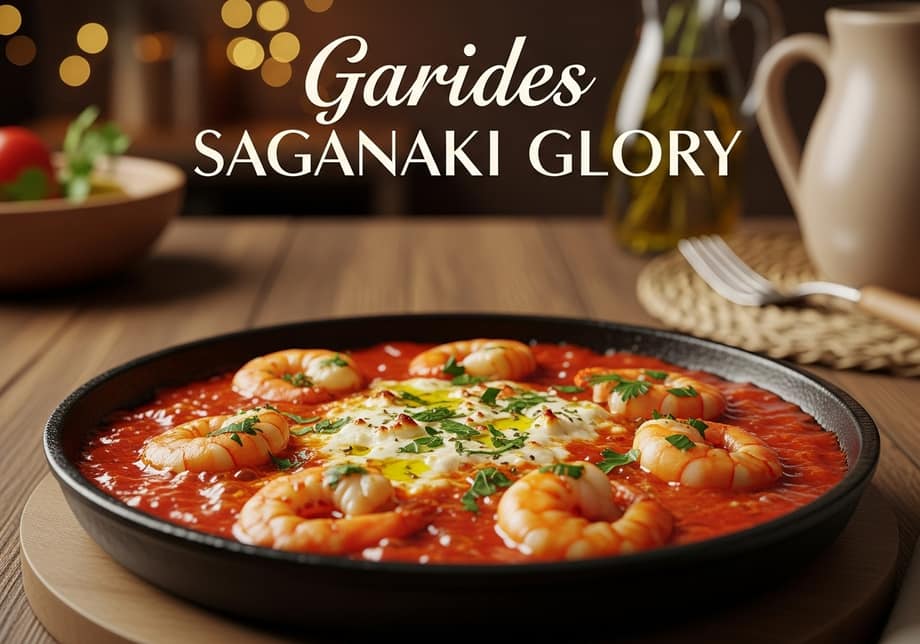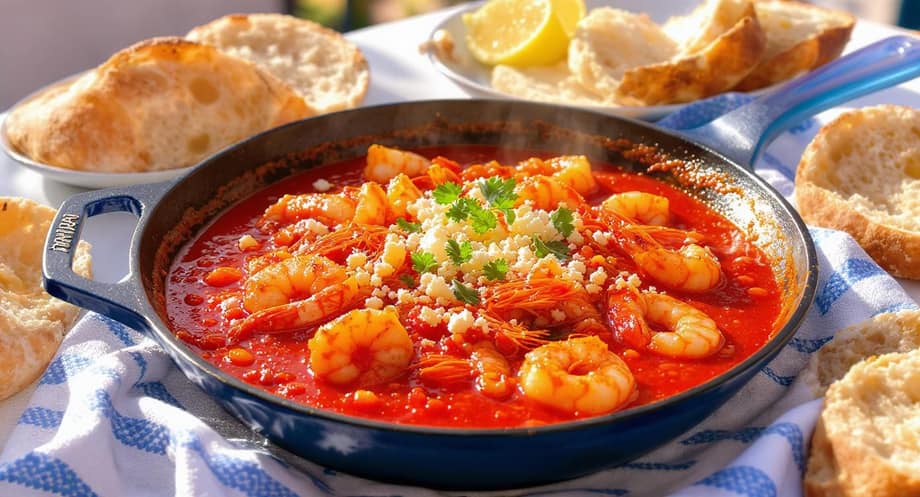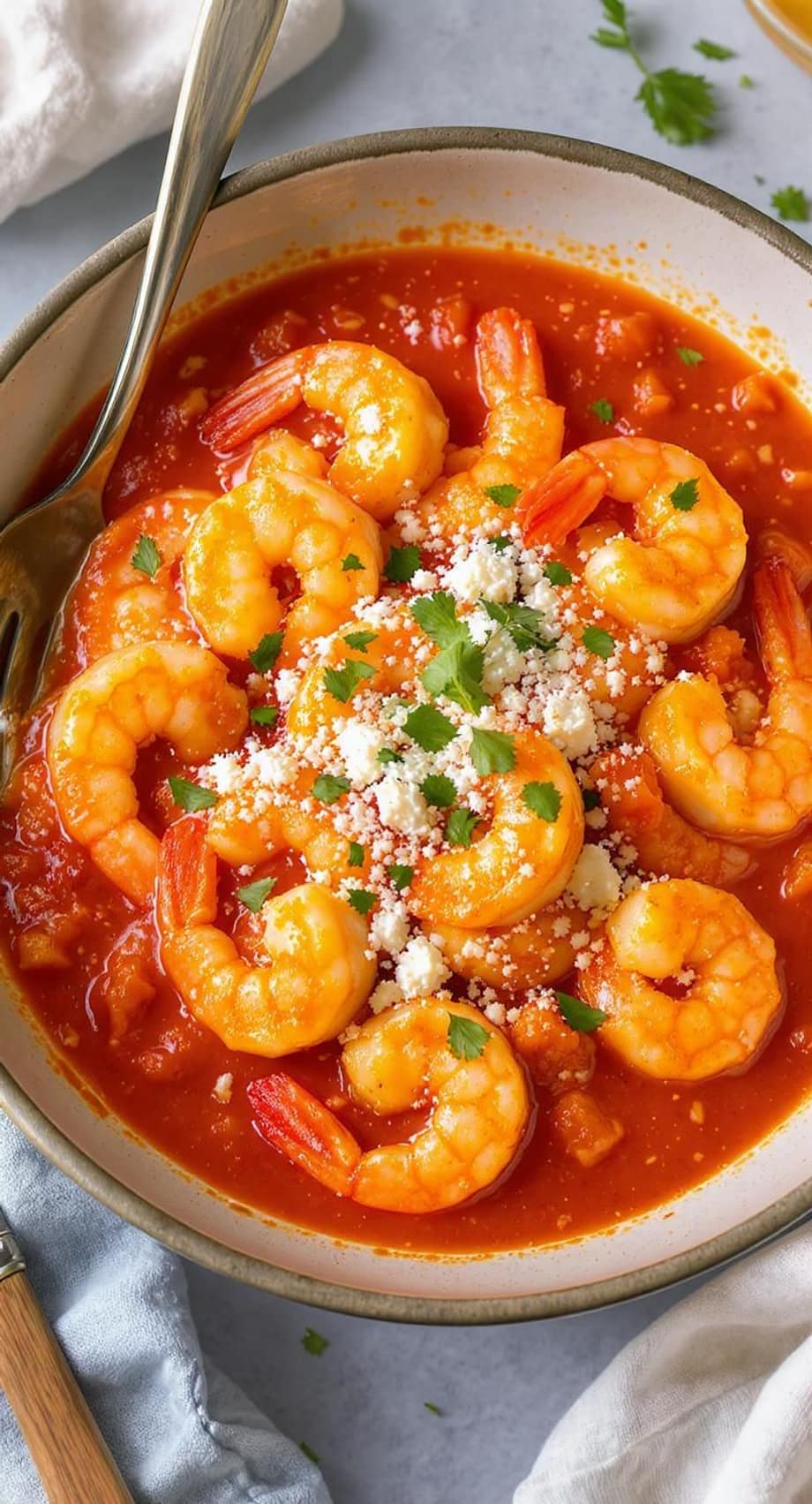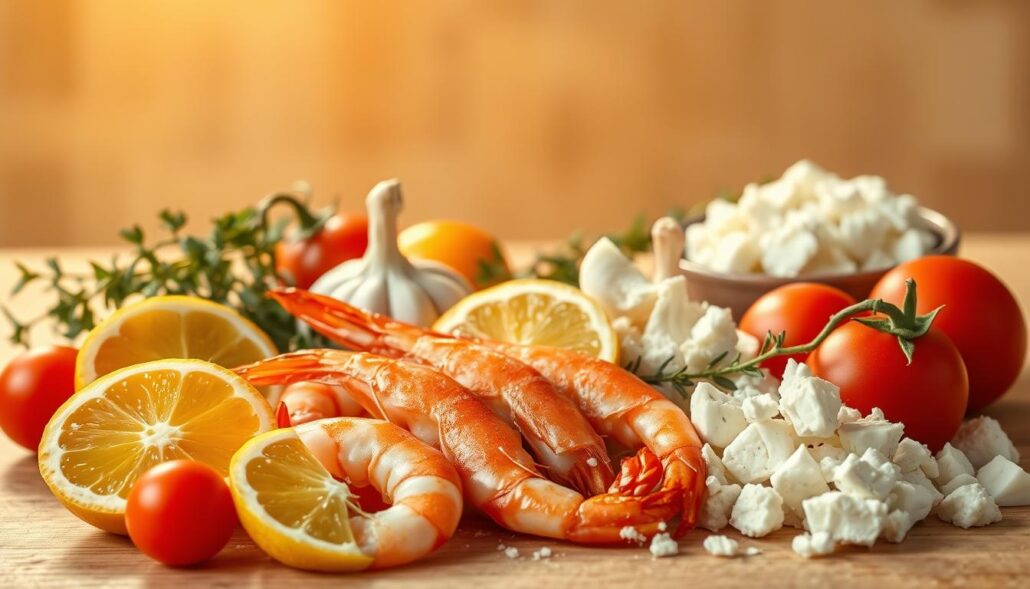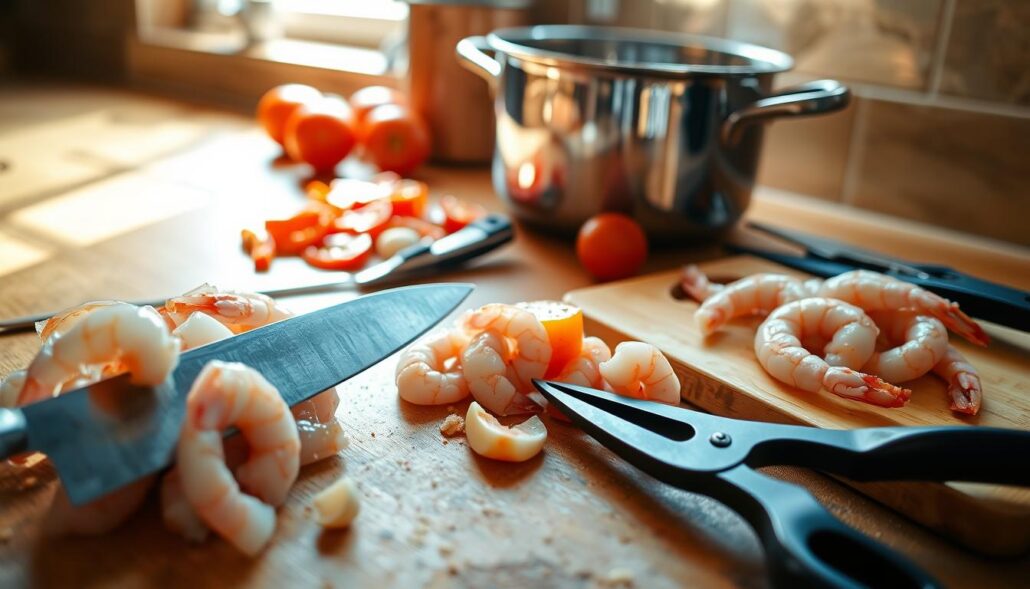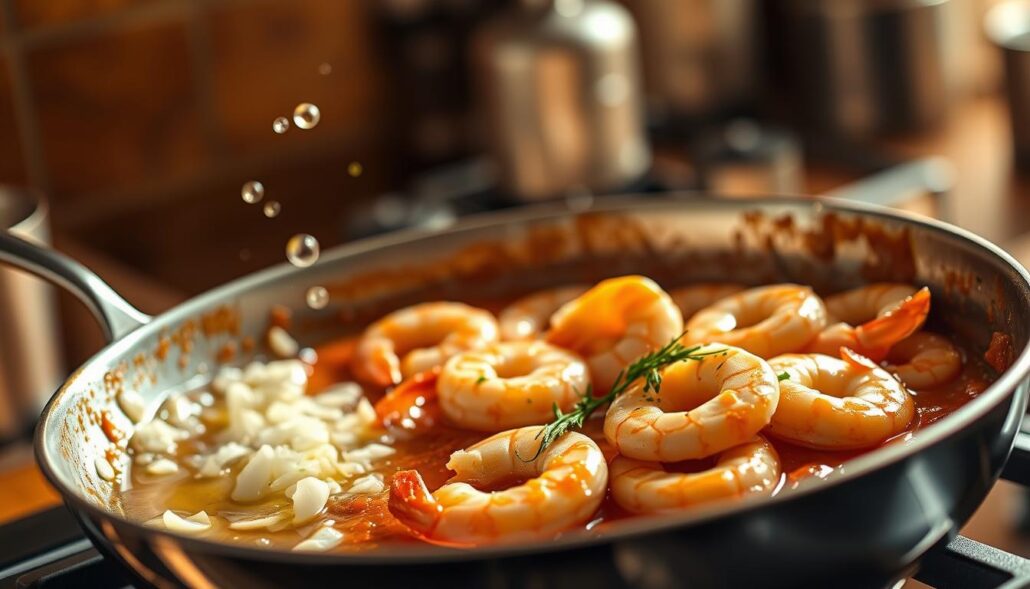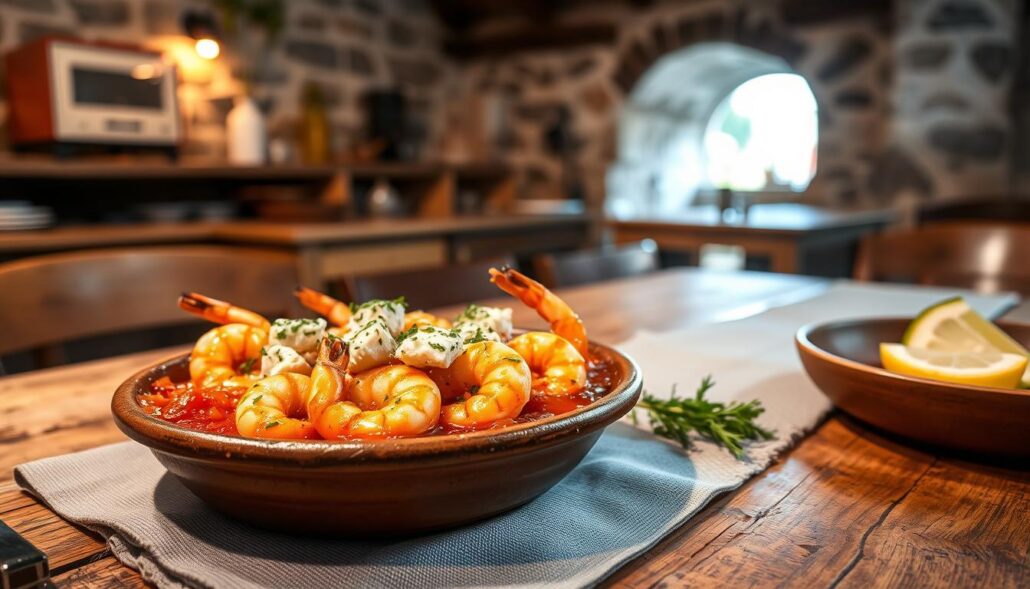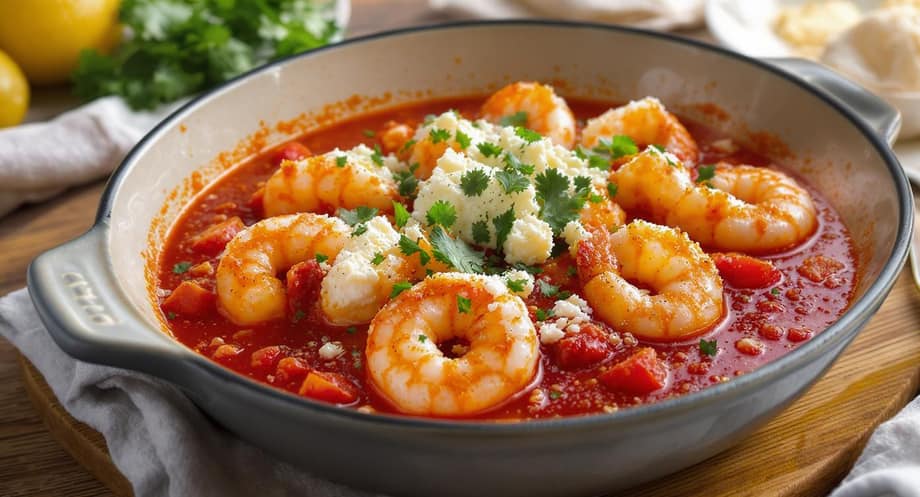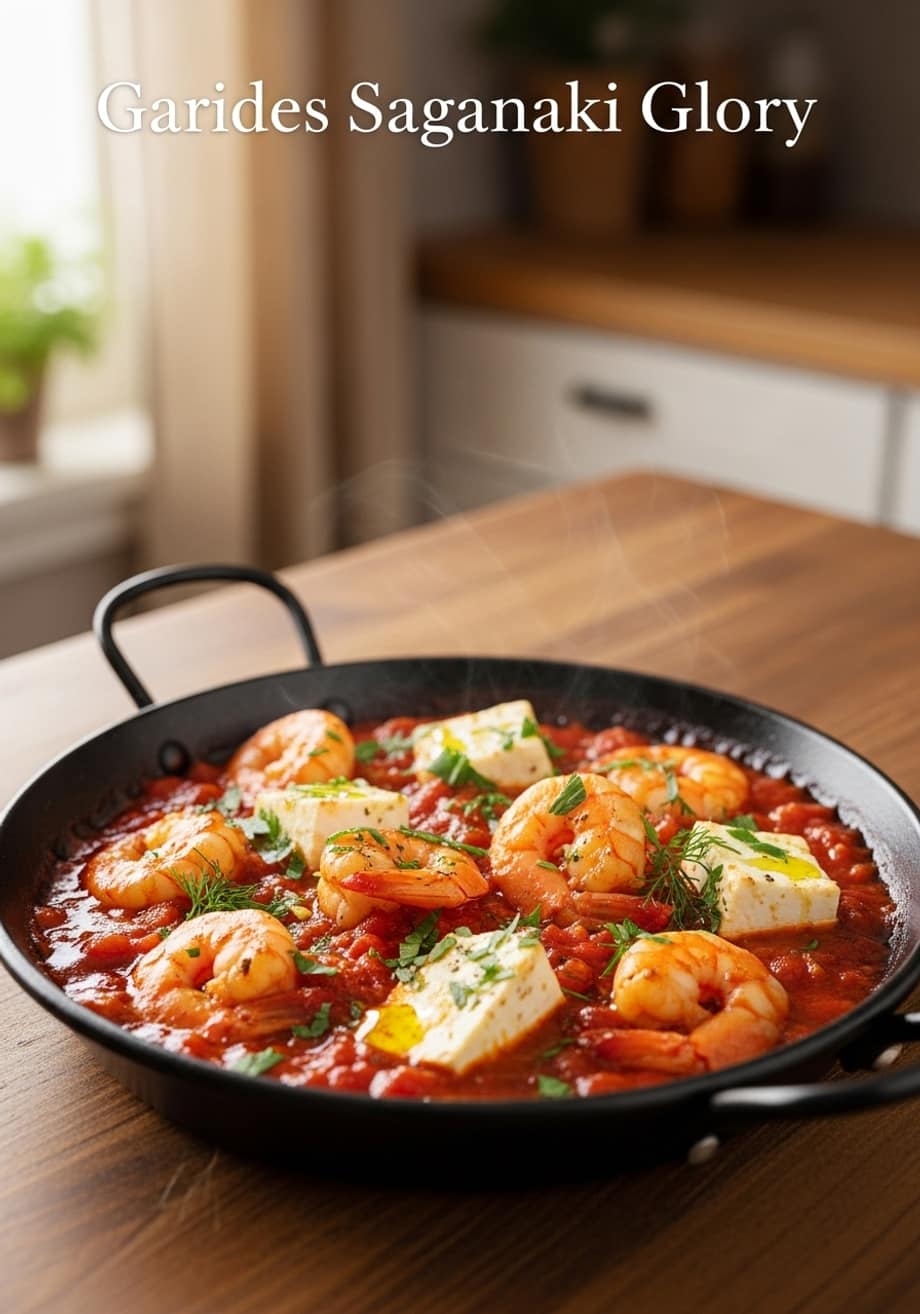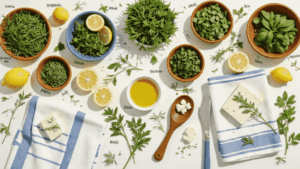Garides Saganaki Glory: Shrimp in Tomato Sauce That Sizzles with Flavor
Did you know over 92% of Greek tavernas feature shrimp saganaki on their menus? This fiery, tomato based dish has become a cornerstone of Mediterranean dining, blending fresh seafood with bold flavours that dance on the palate.
At its heart lies plump shrimp simmered in a rich sauce of sweet tomatoes, aromatic herbs, and a splash of ouzo. The anise kissed spirit adds depth while feta crumbles melt into creamy pockets of salty goodness. What began as humble fishermen’s fare now graces tables worldwide as a beloved Greek shrimp speciality.
You’ll uncover why this recipe stands apart from imitations. Traditional methods transform six simple ingredients into something extraordinary, the trick lies in layering flavours at just the right moment. Fresh dill and oregano lift the sauce, while quality olive oil adds silkiness without overpowering.
Perfect as a sharing platter or main course, it captures Greece’s sun drenched essence. Each bite transports you to whitewashed tavernas overlooking the Aegean. Ready to master this crowd pleaser that’s stood the test of time?
Introduction to Greek Shrimp Saganaki
Imagine plump prawns swimming in a sun kissed tomato bath, kissed by anise flavoured spirits and crowned with creamy feta. This shrimp saganaki recipe captures Greece’s coastal essence in one pan, a vibrant marriage of land and sea that’s as versatile as it is delicious.
Overview of the Dish
At its core, this dish balances juicy shrimp with a rich tomato sauce infused with garlic and oregano. The magic happens when ouzo, Greece’s iconic anise spirit, deglazes the pan, creating complex flavours that simple wine can’t match. Fresh dill adds brightness just before serving.
What truly sets it apart? Its chameleon like adaptability. Serve it sizzling in the pan for a meze spread with crusty bread. Plate it over orzo for a hearty main. The vibrant colours, ruby tomatoes, pink prawns, snow white cheese, make it dinner party gold.
What Makes This Recipe Special?
While many versions exist, this Greek shrimp recipe shines through meticulous layering. Quality olive oil fries the prawns first, building flavour foundations. San Marzano tomatoes offer sweetness without acidity. The feta isn’t just sprinkled, it’s nestled into hot sauce to melt slightly, creating creamy pockets.
Three key elements elevate it:
- Timing: Shrimp added just before serving retain perfect bite
- Balance: Ouzo’s liquorice notes never overpower
- Texture: Crispy edged cheese contrasts velvety sauce
It’s this careful calibration that transforms simple ingredients into something extraordinary. Your guests will taste the difference, even if they never see the effort behind it.
History and Cultural Significance of Saganaki
Ever wondered why your favourite Greek dish arrives sizzling in its own pan? The secret lies in its name and heritage. Saganaki isn’t just about what’s cooked, it’s about how it’s cooked.
Origins of the Term ‘Saganaki’
The word traces back to Turkey’s sahan, a copper serving dish. Greek chefs adapted this into sagani, a two handled frying pan designed for both cooking and presenting food. This clever piece of kit became synonymous with meals cooked and served in the same vessel.
You’ll still find these pans in tavernas today. Their thick bases handle high heat perfectly, creating that signature crust on cheese or prawns. It’s a delicious example of how neighbouring cultures shape each other’s cuisines.
Greek Culinary Traditions
In Greece, saganaki refers to any dish prepared this way. While shrimp saganaki stars on coastal menus, inland regions favour fried feta cheese flambéed tableside. The dramatic ouzo flame isn’t just theatre, it caramelises the cheese beautifully.
Three traditions define this cooking style:
- Using local ingredients like briny kefalotyri cheese
- Maintaining ancient quick cook methods
- Serving straight from pan to plate
Next time your Greek shrimp arrives bubbling in its pan, you’re tasting centuries of culinary evolution. That humble frying pan? It’s been the star of the show all along.
Ingredients Breakdown and Substitutions
Ever wondered what transforms simple ingredients into a Greek taverna classic? The magic lies in balancing quality components with smart swaps when needed. Let’s unpack what makes this dish sing, and how to adapt it without losing its soul.
Essential Ingredients for Maximum Flavour
Start with shrimp (16-20 count), their sweet flesh holds up beautifully in simmering sauce. Uncooked, peeled varieties let you control texture. Greek olive oil forms the base, its peppery notes elevating every bite.
Build depth with yellow onion, red bell peppers, and fresh garlic. These create a sweet savoury foundation. For the sauce, use ripe cherry tomatoes or quality passata. Don’t skimp on dried Greek oregano, its earthy punch defines the dish.
- Ouzo adds anise complexity (swap with white wine if preferred)
- Chilli flakes and paprika bring gentle heat
- Crumbled feta melts into creamy pockets
Alternative Ingredients and Substitutes
No ouzo? A dry white wine works wonders. For dairy free versions, try salty halloumi instead of cheese. Can’t find fresh shrimp? Large prawns retain that juicy bite.
Vegans might use marinated artichokes for briny depth. Gluten free? The dish naturally suits your needs. Remember:
- Kefalotyri cheese offers sharper tang
- Smoked paprika adds rustic warmth
- Fresh dill brightens rich sauces
Essential Kitchen Equipment and Preparation Techniques
Ever stood in your kitchen wondering if you need special gear to nail this dish? Fear not, the right tools and prep make all the difference, but they’re simpler than you think.
Choosing the Right Pan
While traditional sagani pans add authenticity, any heavy based skillet works wonders. Opt for a 30cm diameter model, it gives your shrimp room to sizzle without steaming. Cast iron retains heat beautifully, creating that signature caramelisation.
Key considerations:
- Flat base for even cooking
- Oven safe handles (for finishing under the grill)
- Light coloured interiors to monitor sauce colour
Proper Shrimp Preparation Methods
Start with 500g of seafood (16-20 count). If frozen, thaw in cold water, never warm, to prevent rubberiness. Remove shells completely, though keeping tails adds visual flair. Devein carefully: make a shallow cut along the back and lift the dark vein with a toothpick.
Three golden rules:
- Pat dry before cooking, moisture is the enemy of searing
- Prep all ingredients first, this dish moves fast
- Time it right, overcooked shrimp turn tough in minutes
Step-by-Step Cooking Instructions
Ready to unlock authentic Greek flavours in your kitchen? This method turns simple steps into restaurant-quality results. Let’s transform fresh ingredients into a vibrant seafood masterpiece.
Creating the Tomato Sauce Base
Start by heating olive oil in your skillet over medium heat. Sauté diced onion for 5 minutes until glassy. Add minced garlic and red pepper strips, their sweetness balances the sauce perfectly.
Toss in halved cherry tomatoes, chilli flakes, oregano, and smoked paprika. Stir for 5 minutes until tomatoes soften. Now comes the flavour boost: stir in tomato paste and cook 3 minutes to deepen its richness.
- Pour in tomato sauce and season
- Simmer 3 minutes to meld flavours
- Adjust heat to prevent sticking
Cooking the Shrimp to Perfection
Nestle shrimp into the simmering sauce. Pour in ouzo, it’ll sizzle as the alcohol burns off, leaving subtle anise notes. Cover and cook 5 minutes. The steam gently firms the seafood without toughening it.
Uncover and crumble feta over the top. Let it warm through for 3 minutes, the cheese softens but holds its shape. Finish with fresh parsley for a pop of colour and freshness.
- Use medium low heat for even cooking
- Never stir after adding feta
- Serve immediately for best texture
Perfect Garides Saganaki: Essential Tips & Techniques
What separates a good shrimp saganaki from a great one? It’s all in the technique. This dish rewards precision, a dance between heat management and flavour layering that transforms simple ingredients into something sublime. Let’s explore the professional secrets that ensure your authentic Greek shrimp saganaki recipe sings with every bite.
Key Techniques for a Flavourful Dish
Start with spice calibration. A pinch of chilli flakes should whisper warmth, not shout, you want to highlight the ouzo’s anise notes, not mask them. Season in stages: salt your onions as they soften, pepper the tomato sauce once it thickens. This builds depth without overwhelming the shrimp’s natural sweetness.
Watch for visual cues. Translucent onions signal it’s time to add garlic. When prawns curl into tight ‘C’ shapes and blush coral pink, they’re done, any longer risks rubberiness. Crumble feta just before serving so it softens without dissolving into the sauce.
Timing and Temperature Control
Your skillet should maintain a steady medium low heat. High temperatures toughen seafood faster than you can say “opa!” For 500g of shrimp (16-20 count), 90 seconds per side usually suffices. They’ll finish cooking in the residual heat of the tomato sauce.
Work like a Taverna chef, have all ingredients prepped before firing the hob. Once you start sautéing, the recipe moves fast. Remember: shrimp added too early become overcooked bystanders; added too late, they’ll underperform. Timing isn’t everything, it’s the only thing.
Serving Suggestions and Pairing Recommendations
The right accompaniments transform your Greek shrimp creation from a simple dish to a Mediterranean feast. Whether you’re hosting friends or enjoying a cosy supper, these pairings highlight the vibrant flavours without overshadowing the star of the show.
Best Breads and Accompaniments
No shrimp saganaki experience is complete without crusty bread to mop up every drop of sauce. Opt for a rustic sourdough loaf or warm pitta for authentic taverna vibes. Drizzle leftover olive oil from the pan over torn chunks, it’s liquid gold infused with tomato and herbs.
For heartier meals, spoon the dish over fluffy basmati rice. The grains absorb the rich tomato base beautifully, creating a satisfying one bowl supper. Crumble extra feta cheese on top for salty contrast.
Side Dishes to Enhance the Meal
Balance the dish’s richness with zesty sides. A crisp Greek salad cuts through the sauce’s intensity, while roasted courgettes add earthy sweetness. For wine pairings, choose a citrusy Assyrtiko white, its acidity mirrors the tomatoes’ brightness.
Three winning combinations:
- Lemon infused rice with fresh dill
- Chargrilled asparagus spears
- Marinated olives and pickled peppers
Finish with a drizzle of good olive oil and crusty bread on the side. Your Greek shrimp masterpiece now has the company it deserves.

